Ion Triumph Handleiding
Bekijk gratis de handleiding van Ion Triumph (3 pagina’s), behorend tot de categorie Speaker. Deze gids werd als nuttig beoordeeld door 103 mensen en kreeg gemiddeld 4.7 sterren uit 52 reviews. Heb je een vraag over Ion Triumph of wil je andere gebruikers van dit product iets vragen? Stel een vraag
Pagina 1/3

Manual Version 1.4
Triumph Quickstart Guide
Box Contents
Triumph
Micro-USB Cable
Quickstart Guide / Safety & Warranty Information
Support
Note: Make sure the battery is completely charged prior to first use for maximum battery life.
For the latest information about this product (documentation, technical specifications, system
requirements, compatibility information, etc.) and product registration, visit ionaudio.com.
For additional product support, visit ionaudio.com/support.
Features
Note: If the front speaker grill fills with water, the sound will be muffled until the water has drained.
Top Panel
1. Power On/Off: Press and hold this button to turn Triumph
on/off. While Triumph is connected to a power source, it does
not need to be powered on to charge the battery. Double press
this button to enable/disable voice prompts.
Note: Triumph will power off after 15 minutes if there is no audio playing from Bluetooth, FM, or Aux
sources.
2. Charging/FM LED: The LED is solid red when the battery is charging. When the power is on and the
battery is fully charged, the red LED will turn off. When in FM mode, this LED is solid green and blinks
slowly when in FM Preset Creation mode.
Note: A voice prompt will be heard when the battery needs charging.
3. Bluetooth Button: Press this button briefly to begin Bluetooth connecting. Press and hold this button
to disconnect a paired Bluetooth device.
4. Bluetooth LED: This blinks blue when Bluetooth pairing or illuminates solid blue when connected to a
Bluetooth device.
5. -: Press and release to decrease the speaker volume on Triumph. Press and hold to go to the previous
Bluetooth track or FM station.
6. +: Press and release to increase the speaker volume on Triumph. Press and hold to go to the next
Bluetooth track or FM station.
7. Play/Pause / Call Receive/End: In Bluetooth mode, press this button to play or pause a track from a
connected Bluetooth device. In FM mode, press this button to select a previously saved preset
station.
When Bluetooth-paired, press and release this button to answer a phone call. The phone’s ringtone
will be heard through Triumph’s speaker until the call is answered. When the call has been
disconnected, Triumph will resume playing music. To reject an incoming call, press and hold this
button.
Press and hold this button for 2 seconds to enable your connected smartphone's voice assistant (e.g.
Siri®, Google®, etc), and then speak into the microphone.
8. FM Mode: Press this button to enter FM mode. Hold the button for 3 seconds to enter FM Preset
Creation mode.
Rear Panel
1. Micro USB Port: Use the included micro-USB cable to connect this
port to a computer or power adapter (DC 5V, 2A; sold separately) to
charge Triumph.
2. Auxiliary Input: This stereo 3.5 mm (1/8”) input can be used to
connect a CD player, MP3 player, or other audio source.
Notes: Cover the Aux In and the micro-USB port with the cap firmly
pressed in when using Triumph in water.
Make sure Triumph and its connections are dry before charging.
Never charge when wet.
3. LED Light Button: Press this button to turn the lights on/off.
Bluetooth Pairing
To pair a Bluetooth device:
1. Turn on your Bluetooth device.
2. Power on Triumph and it will automatically go into pairing mode to search for Bluetooth devices. You
will know you are in pairing mode when the Bluetooth LED is slowly flashing.
3. Navigate to your Bluetooth device’s setup screen, find Triumph and connect. Do not attempt to
connect to Triumph BLE.
Note: If your Bluetooth device prompts for a pairing code, enter 0000.
To disconnect a Bluetooth device:
1. Press and hold the Bluetooth button to disconnect a paired Bluetooth device.
2. To connect to another Bluetooth device, repeat step 3 above.
App Control
IMPORTANT: To ensure the best possible experience with the app, use the most current Android OS or
iOS on your device.
Note: Ensure that your device has internet access via your service provider or wireless connection. You
can also download the app on your computer, but remember to connect and sync your device to transfer
the app.
Follow these steps to download the free app on your device:
1. Open the Apple App Store or Google Play on your device.
2. Search for the ION Sound XP app.
3. Follow the on-screen instructions to download and install the app.
4. Once downloaded, the ION Sound XP app will appear on your device's home screen.
Using the Phone
Note: You must power on and pair Triumph with your Bluetooth device before using it to listen to music
or as a speakerphone.
When you have an incoming call, Triumph’s speaker will play a ringtone.
1. To answer the call, press Triumph's Call Receive button.
Note: If you get an incoming call during music playback, the music will pause until you end the call.
2. Speak into the microphone and adjust the call volume using the Volume buttons.
3. To end the call, press the Call End button.
4. To reject an incoming call, press and hold the Call Receive button.
Using the Radio
Selecting a Radio Station:
1. Press the FM button.
2. Select a radio station using the - +/ buttons.
Saving a Preset:
1. Press the FM button to choose FM Radio. The Charging/FM LED will illuminate solid green.
2. Press and hold the - +/ buttons to select a FM radio station that you want to save as a preset.
A voice prompt will be heard identifying the selected station.
3. Press and hold the FM button for 3 seconds to enter Preset Creation mode.
4. Press and hold the - +/ buttons to select from one of the 6 preset locations. For each button press of - or
+, the unit will say the active preset number (for example, “two”). Once the desired save location is
reached, press and release the FM button to save the station preset. The Charging/FM LED will show 4
quick green flashes to confirm a preset is saved and then exit Preset Save mode and return to FM mode.
Selecting a Preset:
To select from the 6 Preset stations, press and release the Play button in FM radio mode. The tuner will
jump to the next preset location and say the name of the preset location (for example, “three”), and resume
playing the FM station audio.
Note: When audio tones are playing, the FM signal will be temporarily muted.
Stereo-Link™: Linking Two Speakers Together Wirelessly
1. Power on both Triumph speakers. You will hear "Ready to pair."
Note: In order to use Stereo-Link Mode, you cannot have a Bluetooth device connected. If one speaker
is connected to a Bluetooth device, break the connection by pressing and holding the Bluetooth button.
2. With no Bluetooth device connected (blue LEDs on both speakers will blink), on one Triumph double
press the Bluetooth button; repeat this for the second Triumph. The Triumphs will search for each other
to link as their blue LEDs begin to blink fast.
3. Wait about 10-30 seconds for the Triumphs to find each other. Once “linked”, one Triumph will say
“Paired” (if the voice prompts are enabled). Now that the two speakers are “linked,” one speaker’s blue
LED will be lit solid, while the other speaker’s blue LED will blink slowly to indicate it’s ready to pair the
stereo-linked speakers to your Bluetooth device (e.g., your phone).
4. When the Triumphs are wirelessly linked to play in stereo, navigate to your Bluetooth device’s setup
screen, find Triumph and connect.
5. Once your smartphone is paired, you will hear “Paired” (if the voice prompts are enabled) and audio can
now play out of both speakers in stereo.
• In Stereo-Link mode: UI Controls on both speakers will be active.
• To exit Stereo-Link mode, double press the Bluetooth button until the speaker goes back into pairing
mode, saying “Bluetooth disconnected.”
• In Stereo-Link mode, press Power to turn off both speakers.
Notes: If a Triumph is in Stereo-Link mode when you power it off, it will be in Stereo-Link the next time you
power it on. That means if two Triumphs are linked when you power them off, they will automatically link
when you power them on as long as they are in close range of each other and powered on within 15
seconds of each other.
If a Triumph is in Stereo-Link mode when you power it off, when you power it back on, it will revert back to
single mode, and be ready to pair to a Bluetooth device if it does not find another Triumph to link to within 15
minutes. To re-enter Stereo-Link mode, follow Steps 1–5 above.
Troubleshooting
If the unit is not charging: Make sure the micro-USB cable is properly connected to the Micro-USB port
and your computer or power adapter (sold separately).
If the sound is distorted: Try lowering the volume control of your sound source. Also, try to reduce the
overall volume of Triumph.
If there is too much bass: Try adjusting the tone or EQ control on your sound source to lower the bass
level. This will allow you to play the music louder before clipping (distortion) occurs.
If you cannot connect your audio device to Triumph via Bluetooth:
• Have your audio device (e.g., smartphone or tablet) and Triumph as close together as possible while
trying to connect. Make sure both the audio device and Triumph are unobstructed by walls, furniture, etc.
• Reset the Bluetooth connection on Triumph to disconnect Triumph from any other audio device and
restart the search process. If this does not work right away, power off Triumph and then power it back
on.
• Reset the Bluetooth connection on your audio device by turning Bluetooth off and back on. You can find
this under the Bluetooth menu in the Settings for your phone or other audio device.
If this does not work, and you have connected to Triumph before, find Triumph in the list of available or
previously connected devices in your audio device's Bluetooth menu, tap the "gear" or “i” icon located
next to it and then select Unpair or Forget. Turn Triumph off and back on and try pairing again once it
reappears in your available devices list.
Note: If Triumph has been paired to another audio device recently that is still within range, you may need
to repeat this process with that audio device to fully disconnect.
Technical Specifications
Output Power: 26 W (peak)
Frequency Response: 80 Hz – 18 kHz
FM Radio Stations: 87.5 MHz – 108 MHz
Bluetooth Module: v5.0
Bluetooth Profile: A2DP, HFP, AVRCP
Bluetooth Range: Up to 100 feet / 30.5 meters
Linked Stereo Range: Up to 30 feet / 10 m between 2 linked speakers*
Water Resistance Class: IP67
Battery: Rechargable Lithium-ion, 7.4V / 2000 mAh
Battery Life: Up to 20 hours
Recharge Time: Up to 4 hours
Aux Input: 3.5 mm (1/8”) line-level
Power: via micro-USB, 5V, 2A
Dimensions (depth x width x height): 2.95” x 10.0” x 9.0” / 75 x 255 x 230 mm
Weight: 2.15 lbs. / .98 kg
Specifications are subject to change without notice.
*Linked range between 2 speakers is affected by obstructions, including water. For optimal performance, place in a location free
from obstructions. Bluetooth and wireless reception and range are affected by walls, obstructions, and movement. For optimal
performance, place the product in the center of the room so it is unobstructed by walls, furniture, etc. Battery life may vary based on
temperature, age, and volume usage of product.
1
2
53
47
6 8
AUX INCHARGE
5V 2A
12
3

Manual Version 1.4
Guía de inicio rápido Triumph
Contenido de la caja
Triumph
Cable micro-USB
Guía de inicio rápido / Manual sobre la seguridad y
garantía
Soporte
Nota: Para asegurar una máxima vida útil de la batería, asegúrese de que esté completamente cargada
antes de utilizarla por primera vez.
Para obtener la información más reciente acerca de este producto (documentación, especificaciones
técnicas, requisitos de sistema, información de compatibilidad, etc.) y registrarlo, visite ionaudio.com.
Para obtener soporte adicional del producto, visite ionaudio.com/support.
Características
Nota: Si el altavoz frontal se llena de agua, el sonido se amortiguará hasta que el agua se haya drenado.
Panel superior
1. Encendido/apagado: Mantenga pulsado este botón para encender
o apagar el Triumph. Mientras el Triumph esté conectado a un
suministro de energía eléctrica, no es necesario encenderlo para que
cargue la batería. Presione dos veces este botón para habilitar /
deshabilitar las indicaciones de voz.
Nota: El Triumph se apagará tras 15 minutos si no hay reproducción de audio de fuentes Bluetooth, FM
o Aux. Nunca se apagará automáticamente cuando esté en modo FM, salvo que la batería se quede sin
carga.
2. Indicador de carga/LED FM: El LED se iluminará con luz roja permanente cuando la batería se esté
cargando. Cuando esté encendido y la batería esté totalmente cargada, este LED rojo se apagará. En el
modo FM, este LED permanece iluminado con luz verde y parpadea lentamente cuando se encuentra en
modo de creación de presets de FM.
Nota: Se escuchará un mensaje de voz cuando la batería necesite cargarse.
3. Botón Bluetooth: Pulse este botón brevemente para comenzar la conexión Bluetooth. Mantenga
pulsado este botón para desconectar un dispositivo Bluetooth apareado.
Pulse el botón Bluetooth dos veces para activar o desactivar los avisos de voz.
4. LED Bluetooth: Parpadea durante el apareamiento de Bluetooth o se ilumina con luz azul fija cuando
está conectado a un dispositivo Bluetooth.
5. -: Pulse y suelte para disminuir el volumen del altavoz del Triumph. Mantenga presionado para ir a la
pista Bluetooth o estación FM anterior.
6. +: Pulse y suelte para aumentar el volumen del altavoz del Triumph. Mantenga presionado para ir a la
siguiente pista Bluetooth o estación FM.
7. Reproducir/Pausa / Atender/Finalizar llamada: Púlselo para reproducir o hacer pausa en una pista de
un dispositivo Bluetooth conectado.
Con un dispositivo Bluetooth apareado, pulse y suelte este botón para atender una llamada. Se
escuchará el tono de llamada del teléfono a través del altavoz del Triumph hasta que se atienda la
llamada. Cuando la llamada haya finalizado, el Triumph continuará reproduciendo música. Para rechazar
una llamada entrante, mantenga pulsado este botón.
Pulse y suelte este botón para seleccionar un preset de estación guardado previamente. Mantenga
pulsado este botón durante 2 segundos para activar el asistente de voz de su teléfono inteligente
(smartphone) conectado (por ej., Siri®, Google®, etc.) y luego háblele al micrófono.
8. Modo FM: Pulse este botón para entrar al modo de FM. Mantenga pulsado el botón durante 3 segundos
para entrar al modo de creación de presets.
Panel posterior
1. Puerto micro USB: Utilice el cable micro USB incluido para conectar este puerto
a un ordenador o adaptador de corriente (5 V de CC, 2A; se vende por separado)
para cargar el Triumph.
2. Entrada auxiliar: Esta entrada estéreo de 3,5 mm (1/8 pulg.) se puede utilizar
para conectar un reproductor de CD, un reproductor de MP3 u otra fuente de
audio.
Notas: Cubra la entrada auxiliar, el puerto micro-USB y el cable de alimentación con la tapa presionado
firmemente antes de usar el triunfo en el agua.
Asegúrese de que el Triumph y sus conexiones estén secas antes de cargarlo. Nunca lo cargue si está
húmedo.
3. Botón de luz LED: Presione este botón para encender / apagar las luces.
Apareamiento Bluetooth
Cómo aparear un dispositivo Bluetooth
1. Encienda su dispositivo Bluetooth.
2. Encienda el Triumph, que pasará automáticamente al modo de apareamiento para buscar dispositivos
Bluetooth. Se dará cuenta de que está en modo de apareamiento cuando el icono Bluetooth esté
parpadeando.
3. Navegue a la pantalla de configuración Bluetooth de su dispositivo, busque Triumph y establezca la
conexión. No intente conectarse a Triumph BLE.
Nota: Si su dispositivo Bluetooth solicita un código de apareamiento, ingrese 0000.
Cómo desconectar un dispositivo Bluetooth:
1. Mantenga presionado el botón Bluetooth paradesconectar un dispositivo Bluetooth apareado.
2. Para conectarse a otro dispositivo Bluetooth repita el paso 3 mencionado anteriormente.
Contrôle d'application
IMPORTANT : Afin de profiter de la meilleure expérience possible avec l’application, assurez-vous d’avoir la
toute dernière version de Android OS ou de iOS sur votre appareil.
Remarque : Veuillez vous assurer que votre appareil dispose d’une connexion Internet. Vous pouvez
également télécharger l’application gratuite sur votre ordinateur, mais n’oubliez pas de connecter et de
synchroniser votre appareil afin de transférer l’application.
Veuillez suivre les étapes ci-dessous afin de télécharger l’application sur votre appareil :
1. Accédez au Apple App Store ou à Google Play à partir de votre appareil.
2. Recherchez l’application ION Sound XP.
3. Suivez ensuite les consignes à l'écran afin de la télécharger et de l'installer.
4. Une fois téléchargée, l’application s’affiche sur la fenêtre d’accueil de votre appareil. ION Sound XP
Trademarks & Licenses
ION Audio is a trademark of inMusic Brands, Inc., registered in the U.S. and other countries. App Store is a trademark of Apple Inc.,
registered in the U.S. and other countries. Android and Google Play are registered trademarks of Google Inc. The Bluetooth word
mark and logos are owned by the Bluetooth SIG, Inc. and any use of such marks by ION Audio is under license. All other product
names, company names, trademarks, or trade names are those of their respective owners.
Cómo utilizar el teléfono
Nota: Debe encender y aparear el Triumph con su dispositivo Bluetooth antes de usarlo a fin de poder
utilizarlo para escuchar música o como teléfono manos libres.
Cuando tenga una llamada entrante, el altavoz del Triumph reproducirá un tono de llamada.
1. Para contestar la llamada, pulse el botón Call Receive (Atender llamada) del Triumph.
Nota: Si recibe una llamada entrante durante la reproducción de música, ésta se pondrá en pausa hasta
que termine la llamada.
2. Háblele al micrófono y ajuste el volumen de la llamada utilizando los botones Volume (volumen).
3. Para terminar la llamada, pulse el botón Call End (Terminar de llamada).
4. Para rechazar una llamada entrante, mantenga pulsado el botón Call Receive.
Cómo usar la radio
Selección de una estación de radio:
1. Pulse el botón FM.
2. Seleccione una estación de radio utilizando los botones - +/ .
Guardado de un preset:
1. Pulse el botón FM para elegir una radio de FM. El Charging/LED FM se iluminará con luz verde fija.
2. Mantenga pulsado los botones - +/ para seleccionar una estación de FM que desee guardar como un
preset.
Se escuchará un indicativo de voz que identifica la estación seleccionada.
3. Mantenga pulsado el botón FM durante 3 segundos para activar el modo de creación de presets.
4. Mantenga pulsado los botones - +/ para seleccionar una de las 6 ubicaciones para presets. Por cada
pulsación del botón - o +, la unidad dice el número de preset activo (por ejemplo, "dos"). Una vez
alcanzada la ubicación de memorización deseada, pulse y suelte el botón FM para guardar el preset de
la estación. El Charging/LED FM mostrará 4 destellos verdes rápidos para confirmar que se memorizó
el preset y luego sale del modo de guardado de presets y vuelve al modo FM.
Selección de presets:
Para seleccionar uno de los 6 presets de estaciones, pulse y suelte botón Play en modo de radio de FM. El
sintonizador saltará a la siguiente ubicación de preset, dirá el nombre de la ubicación del preset (por
ejemplo, "tres") y reanudará la reproducción del audio de la estación de FM.
Nota: Cuando se están reproduciendo los tonos de audio, la señal de FM se silencia temporalmente.
Stereo-Link™: Enlace de dos altavoces entre sí de forma inalámbrica
1. Encienda ambos altavoces Triumph. Escuchará "Ready to pair."
Nota: Para poder usar el modo Stereo-Link, no podrá tener un dispositivo Bluetooth conectado. Si hay
un altavoz conectado a un dispositivo Bluetooth, interrumpa la conexión manteniendo pulsado el botón
Bluetooth.
2. Si no hay ningún dispositivo Bluetooth conectado (los LED azules en ambos altavoces parpadearán),
pulse dos veces el botón Bluetooth en uno de los Triumph; repita este procedimiento para el segundo
Triumph. Los Triumphs se buscarán entre sí para que sus LED azules comiencen a parpadear
rápidamente.
3. Espere de 10 a 30 segundos hasta que los Triumph se encuentren. Una vez enlazados, uno de los
Triumph dirá “Paired” (si los avisos de voz están activados). Ahora que ambos altavoces están
"enlazados", el LED azul de un altavoz se iluminará, mientras que el LED azul del otro altavoz parpadeará
lentamente para indicar que está listo para aparear los altavoces estéreo enlazados a su dispositivo
Bluetooth (por ej., su teléfono).
4. Cuando los Triumph estén enlazados de forma inalámbrica para reproducir en estéreo, navegue a la
pantalla de configuración Bluetooth de su dispositivo, busque Triumph y establezca la conexión.
5. Una vez apareado su teléfono inteligente (smartphone), escuchará “Paired” (si los avisos de voz están
activados) y podrá reproducir audio a través de ambos altavoces en estéreo.
• En modo Stereo-Link: Los controles de la interfaz del usuario en ambos altavoces estarán activados.
• Para salir del modo Stereo-Link, pulse dos veces el botón Bluetooth hasta que el altavoz regrese al
modo de apareamiento diciendo “Bluetooth disconnected.”
• Estando en el modo Stereo-Link, pulse Power (Encendido) para apagar ambos altavoces.
Notas: Si un Triumph se encuentra en modo Stereo-Link cuando lo apaga, estará en modo Stereo-Link la
próxima vez que lo encienda. Eso implica que si dos Stereo-Link están enlazados cuando los apaga, se
enlazarán automáticamente cuando los encienda siempre que estén dentro del alcance del otro y se
enciendan con menos de 15 segundos de diferencia entre sí.
Si un Triumph se encuentra en modo Stereo-Link cuando lo apaga, al encenderlo nuevamente regresará al
modo mono/individual, y estará listo para aparearse con un dispositivo Bluetooth si no encuentra otro
Triumph con el cual enlazarse en un período de 15 minutos. Para volver a entrar al modo Stereo-Link, repita
los pasos 1 a 5 anteriores.
Solución de problemas
Si la unidad no se carga: Asegúrese de que el cable micro-USB esté conectado correctamente al puerto
micro-USB y a la toma de corriente o ordenador (vende por separado).
Si el sonido está distorsionado: Pruebe bajando el control de volumen de su fuente de sonido o
instrumento musical. Pruebe también reduciendo el volumen general del Triumph.
Si los graves son demasiado fuertes: Intente ajustando el control de tono o ecualización de su Triumph o
fuente de sonido para reducir el nivel de graves. De esta forma podrá reproducir la música con más volumen
antes de que se produzca el recorte (distorsión).
Si no logra reproducir música desde una unidad flash: El puerto USB sea solo para cargar dispositivos
USB.
Si no puede conectar su dispositivo de audio al Triumph mediante Bluetooth:
• Mantenga su dispositivo de audio (por ej., teléfono inteligente [smartphone] o tableta) y el Triumph lo
más cerca posible entre sí al realizar la conexión. Asegúrese que tanto el dispositivo de audio como el
Triumph no estén obstruidos por paredes, muebles, etc.
• Reinicie la conexión Bluetooth del Triumph para desconectarlo Triumph de cualquier otro dispositivo de
audio y reinicie el proceso de búsqueda. Si esto no funciona en seguida, apague el Triumph y luego
vuelva a encenderlo.
• Reinicie la conexión Bluetooth de su dispositivo de audio apagando el Bluetooth y luego volviendo a
encenderlo. Puede encontrar esta opción dentro del menú Bluetooth en los ajustes de su teléfono o
dispositivo de audio.
Si esto no funciona y p2-ya se había conectado al Triumph anteriormente, busque Triumph en la lista de
dispositivos disponibles o previamente conectados en el menú Bluetooth de su dispositivo de audio,
toque el icono de engranaje o "i" ubicado junto a él y luego seleccione Desaparear u Olvidar. Apague el
Triumph, luego vuelva a encenderlo e intente aparearlo nuevamente una vez que vuelva a aparecer en su
lista de dispositivos disponibles.
Nota: Si Triumph p2-ya p2-ha sido recientemente apareado con otro dispositivo de audio que aún se encuentre
dentro del alcance, es posible que tenga que repetir este proceso con ese dispositivo de audio para
desconectarlo completamente.
1
2
53
47
6 8
AUX INCHARGE
5V 2A
12
3

Manual Version 1.4
Safety & Warranty Information
English
For complete warranty information: ionaudio.com/warranty
Important Safety Instructions
1. Read these instructions. Keep these instructions. Heed all warnings. Follow all Instructions.
2. Do not defeat the safety purpose of the polarized or grounding-type plug (if applicable). A polarized plug has two
blades with one wider than the other. A grounding type plug has two blades and a third grounding prong. The wide
blade or the third prong is provided for your safety. If the provided plug does not fit into your outlet, consult an
electrician for replacement of the obsolete outlet.
3. Protect the power cord from being walked on or pinched particularly at plugs, convenience receptacles, and the point
where they exit from the apparatus.
4. Use only the cart, stand, tripod, bracket or table specified by the manufacturer, or sold with the apparatus
(if applicable). When a cart is used, use caution when moving the cart/apparatus combination to avoid
injury from tip-over.
5. Unplug this apparatus during lightning storms.
6. Power Sources (if applicable): This product should be connected to a power supply only of the type described in
these operating instructions, or as marked on the unit.
7. Caution: Danger of explosion if battery is incorrectly replaced. Replace only with the same or equivalent type.
Batteries (a battery pack or an installed battery) shall not be exposed to excessive heat such as sunshine, fire, etc.
(This applies only if your product uses a battery.)
8. Protective earthing terminal (if applicable): The apparatus should be connected to a mains socket outlet with
a protective earthing connection.
9. For Class II apparatus only (if applicable): This symbol means the equipment is a Class II or double-
insulated electrical appliance. It has been designed in such a way that it does not require a safety connection
to electrical earth.
10. Class II Wiring (if applicable): To reduce the risk of electric shock, the external wiring connected to the terminals
with “Class II Wiring” requires Class II wiring installed by an instructed person or the use of ready-made leads or
cords.
11. This apparatus is for professional use only. Intended operational climate: moderate.
12. (If applicable) When moving or not using the appliance, secure the power cord (e.g., wrap it with a cable tie). Be
careful not to damage the power cord. Before using it again, make sure the power cord has not been damaged. If
the power cord has been damaged at all, bring the unit and cord to a qualified service technician for repair or
replacement as specified by the manufacturer.
13. Warning (if applicable): Excessive sound pressure (high volumes) from headphones can cause hearing loss.
14. Warning (if applicable): Please refer to any important information (e.g., electrical, safety, etc.) printed on the exterior
bottom enclosure or rear panel before installing or operating the product.
15. Warning (if applicable): Terminals marked with the lightning bolt symbol may be of sufficient magnitude to
constitute a risk of electric shock.
Safety Notices
CAUTION: TO REDUCE THE RISK OF ELECTRIC SHOCK, DO NOT
REMOVE ANY COVER. NO USER- SERVICEABLE PARTS INSIDE.
REFER SERVICING TO QUALIFIED SERVICE PERSONNEL ONLY.
DANGEROUS VOLTAGE: The lightning flash with arrowhead symbol within the equilateral triangle is intended
to alert the user to the presence of un-insulated “dangerous voltage” within the product’s enclosure that may
be of sufficient magnitude to constitute a risk of electric shock.
INSTRUCTIONS: The exclamation point within the equilateral triangle is intended to alert the user to the
presence of important operating and maintenance (servicing) instructions in the literature accompanying this
appliance.
WARNING: To reduce the risk of fire or electrical shock, do not expose this appliance to rain or moisture.
Electrical equipment should NEVER be kept or stored in damp environments.
NOTICE CONCERNING FCC REGULATIONS: You are cautioned that changes or modifications not expressly approved
by the part responsible for compliance could void the user’s authority to operate the equipment. This equipment has
been tested and found to comply with the limits for a Class B digital device, pursuant to part 15 of the FCC rules. These
limits are designed to provide reasonable protection against harmful interference in a residential installation. This
equipment generates uses and can radiate radio frequency energy and, if not installed and used in accordance with the
instructions, may cause harmful interference to radio communications. However, there is no guarantee that interference
will not occur in a particular installation. If this equipment does cause harmful interference to radio or television reception,
which can be determined by turning the equipment off and on, the user is encouraged to try to correct the interference by
one or more of the following measures: (a) reorient or relocate the receiving antenna; (b) move this unit; (c) increase the
separation between the equipment and receiver; (d) connect the equipment into an outlet on a circuit different from that
to which the receiver is connected; (e) be sure that all cables are properly shielded, using a choke or ferrite where
appropriate; (f) consult the dealer or an experienced radio/television technician for help.
This device complies with Part 15 of the FCC rules. Operation is subject to the following two conditions: (1) this device
may not cause harmful interference, and (2) this device must accept any interference received, including interference that
may cause undesired operation.
FCC Radiation Exposure Statement: This equipment complies with FCC radiation exposure limits set forth for an
uncontrolled environment. This equipment should be installed and operated with a minimum distance of 20 cm between
the radiator and your body.
If apparatus contains a coin/button-cell battery: Warning: Do not ingest the battery—chemical burn hazard.
The remote control supplied with this product contains a coin/button-cell battery. If the coin/button-cell battery is
swallowed, it can cause severe internal burns in just 2 hours and can lead to death. Keep new and used batteries
away from children. If the battery compartment does not close securely, stop using the product and keep it away
from children. If you think batteries might have been swallowed or placed inside any part of the body, seek
immediate medical attention.
Disposal of Batteries (if applicable):
•
Never dispose of any types of batteries in fire or near excessive heat or direct sunlight. Overheated batteries can rupture or
explode.
• If you are unsure of how or where to dispose of a battery, refer to your local ordinances for the proper location, method,
etc.
• Alkaline batteries & lithium button cell batteries: You can safely dispose of alkaline and lithium button cell
batteries with normal household waste. They do not pose a health or environmental risk during normal use or
disposal. (Alkaline batteries are composed primarily of common metals like steel, zinc, and manganese.)
Do not dispose of large amounts of alkaline or lithium button cell batteries in a group. Used batteries are often not
completely “dead.” Grouping them together can bring these “live” batteries into contact with one another, creating
safety risks. To avoid this, insulate each battery with tape or other non-conductive material to ensure it does not
discharge. Proven cost-effective and environmentally safe recycling processes are not yet universally available for
alkaline and lithium button cell batteries. Some communities offer recycling or collection of these batteries. For
more information, refer to your local ordinances or contact your local government.
• Lead-acid batteries: Dispose of lead-acid batteries by bringing them to an electronic waste center or recycling
center, or dispose of them in accordance with your local ordinances. (Rechargeable lead-acid batteries are the
same type used in automobiles and should be disposed of in a similar fashion.)
This device contains licence-exempt transmitter(s)/receiver(s) that comply with Innovation, Science and Economic
Development (ISED) Canada’s licence-exempt RSS(s). Operation is subject to the following two conditions: (1) this device
may not cause interference, and (2) this device must accept any interference, including interference that may cause
undesired operation of the device.
Español
Para información completa sobre la garantía: ionaudio.com/warranty
Instrucciones importantes de seguridad
1. Lea estas instrucciones. Conserve estas instrucciones. Preste atención a las advertencias. Siga todas las
instrucciones.
2. No anule la función de seguridad del enchufe tipo polarizado o con conexión a tierra (si es aplicable). Un enchufe
polarizado tiene dos patillas, una más ancha que la otra. Un enchufe de tipo de conexión a tierra tiene dos patillas y
una clavija de puesta a tierra. La patilla ancha o la tercera clavija son para su seguridad. Si el enchufe provisto no
entra en su tomacorriente, consulte a un electricista y solicítele el reemplazo del tomacorriente obsolete.
3. Proteja el cable de alimentación de modo que no lo pisen ni quede estrangulado, particularmente en los enchufes,
tomacorrientes y el punto donde sale del equipo.
4. Use sólo el carrito, soporte, trípode, ménsula o mesa especificados por el fabricante o vendidos con el
equipo (si es aplicable). Si usa un carrito, tenga cuidado al mover la combinación de carrito/equipo para
evitar que se vuelque y produzca lesiones.
5. Desenchufe este equipo durante las tormentas eléctricas.
6. Suministro eléctrico (si es aplicable): Conecte este producto solamente a un suministro eléctrico del tipo que se
describe en estas instrucciones de operación o según se indique en la unidad.
7. Precaución (si es aplicable): Peligro de la explosión si la batería se substituye incorrectamente. Substituir
solamente por el mismo o el tipo equivalente. Las baterías (un bloque de baterías o una batería instalada) no se
deben exponer a calor excesivo, tal como la luz solar, el fuego, etc.
8. Terminal de conexión a tierra de protección (si es aplicable): El artefacto debe conectarse a un
tomacorriente del suministro eléctrico con una conexión a tierra de protección
9. Solamente para aparatos de Clase II (si aplica): Este símbolo significa que el equipo es un artefacto
eléctrico Clase II o de doble aislamiento. Está diseñado de manera tal que no requiere una conexión de
seguridad a la tierra eléctrica.
10. Cableado de Clase II (si aplica): Para reducir el riesgo de choque eléctrico, el cableado externo conectado a los
terminales marcados como “Cableado de Clase II” requiere la instalación de un cableado de Clase II por una
persona capacitada o el uso de conductores o cables prearmados.
11. Este aparato es para uso profesional únicamente. Climas de funcionamiento previstos: moderado.
12. (Si es aplicable) Cuando traslade o no use el artefacto, sujete el cable de alimentación (por ejemplo, envuélvalo con
un precinto). Tenga cuidado de no dañar el cable de alimentación. Antes de usarlo nuevamente, asegúrese de que
el cable de alimentación no esté dañado. Si dicho cable presenta algún daño, lleve la unidad y el cable a un
técnico de servicio calificado para reparación o reemplazo según lo especifique el fabricante.
13. Advertencia (si aplica): Para evitar daños potenciales al oído, no escuche a niveles elevados de volumen
durante períodos prolongados.
14. Advertencia (si aplica): Antes de instalar u operar el producto, consulte toda la información importante (como la
relativa a electricidad, seguridad, etc.) impresa en la envuelta inferior exterior o el panel trasero.
15. Advertencia (si aplica): Los terminales marcados con el símbolo de relámpago pueden ser de suficiente
magnitud como para presentar un riesgo de choque eléctrico.
Señales de advertencia
PRECAUCIÓN: PARA REDUCIR EL RIESGO DE DESCARGA
ELÉCTRICA NO QUITE NINGUN TAPADERO. DENTRO DE LA
UNIDAD NO HAY COMPONENTES ÚTILES PARA EL UTILIZADOR.
PARA EL SERVICIO SE DEBE DIRIGIRSE SOLAMENTE AL
PERSONAL DE SERVICIO CUALIFICADO.
VOLTAJE PELIGROSO NO AISLADO: La seña de relámpago con la punta de la flecha dentro del triángulo
equilátero está puesto para alertar al utilizador de la presencia del “voltaje peligroso no aislado” dentro del
recinto de producto que puede tener la magnitud suficiente de correr un riesgo de descarga eléctrica.
INSTRUCCIONES: El signo de exclamación, dentro del triángulo equilátero, es para alertar el utilizador de
la presencia de las instrucciones importantes de funcionamiento y de mantenimiento (servicio) en la
literatura que acompaña este dispositivo.
ADVERTENCIA: Para reducir el riesgo de incendio o descarga eléctrica, no exponga este aparato a la lluvia
o a la humedad. Los equipos eléctricos NUNCA deberían guardarse o almacenarse en ambientes húmedos.
AVISO SOBRE LAS REGULACIONES DEL FCC (Federal Communications Commission): Este equipo genera y usa
energía de radiofrecuencia y puede causar interferencia en la recepción de radio y de televisión si no la opera
estrictamente según los procedimientos detallados en este manual de operación.
Esta unidad cumple con las reglas de aparatos informáticos de Clase B en conformidad con las especificaciones en la
Subparte J o Parte 15 de las Reglas FCC, que están diseñadas para proporcionar una protección razonable contra tal
interferencia en una instalación residencial. Sin embargo, no existen garantías de que no ocurrirá una interferencia en
una instalación específica. Si la unidad causa interferencia en alguna recepción de radio o de televisión, intente
reducirla realizando uno o más de los siguientes métodos: (a) reposicione la otra unidad y/o su antena ; (b) mueva esta
unidad ; (c) deje más espacio entre esta unidad y la(s) otra(s) unidad(es); (d) enchufe esta unidad a una toma de
corriente alterna diferente para que esté en un circuito diferente al de los demás equipos ; (e) asegúrese que todos los
cables estén blindados correctamente, usando un inductor o ferrite cuando sea adecuado. Esta nota está en
conformidad con la Sección 15.838 de las Reglas de FCC.
Declaración sobre exposición a las radiaciones según normas de la FCC: Este equipo cumple los límites de
exposición a la radiación establecidos por la FCC para un ambiente no controlado. Este equipo debe instalarse y
hacerse funcionar a una distancia mínima de 20 cm entre el radiador y el cuerpo del usuario.
Si el aparato contiene una pila de tipo botón: Advertencia: No ingiera la batería—peligro de
quemadura química. El control remoto que se suministra con este producto contiene una pila de tipo
botón. Si la misma se ingiere, puede causar quemaduras internas severas en tan solo 2 horas y puede
causar la muerte. Mantenga las pilas nuevas y usadas alejadas de los niños. Si el compartimiento de las
pilas no se cierra de forma segura, suspenda el uso del producto y manténgalo alejado de los niños Si cree
que las pilas pueden haber sido ingeridas o introducidas en alguna parte del cuerpo, busque atención
médica inmediata.
Disposición final de pilas (si aplica):
• Nunca deseche pilas de ningún tipo en el fuego o cerca de fuentes de calor excesivo o luz solar directa. Las pilas
sobrecalentadas pueden romperse o explotar.
• Si no está seguro de cómo o dónde desechar una pila, consulte la ubicación, método, etc. apropiados en sus
reglamentos locales.
• Pilas alcalinas y baterías de celda de litio tipo botón: Puede desechar las pilas alcalinas y las pilas de celda
de litio tipo botón junto con los desechos normales del hogar. No presentan un riesgo a la salud o al
medioambiente durante el uso o disposición final normal. (Las pilas alcalinas están compuestas principalmente
de metales comunes tales como acero, zinc y manganeso).
No deseche grandes cantidades de pilas alcalinas o pilas de celda de litio tipo botón en grupo. Las pilas usadas
a menudo no están completamente “agotadas”. Si se agrupan, estas pilas “activas” pueden entrar en contacto
entre sí y crear riesgos para la seguridad. Para evitar esto, aísle cada pila con cinta u otro material no conductor
para asegurarse de que no se descargue. No se dispone aún a nivel universal de procesos de reciclaje probados,
rentables y seguros para el medio ambiente aplicables a las pilas alcalinas y a las pilas de celda de litio tipo
botón. Algunas comunidades ofrecen el reciclado o recolección de estas pilas. Para obtener más información,
consulte sus reglamentos locales o contacte a su gobierno local.
• Baterías de plomo-ácido: Deseche las pilas de plomo-ácido llevándolas a un centro de residuos electrónicos o a
un centro de reciclaje, o deséchelas de acuerdo a sus reglamentos locales. (Las pilas de plomo-ácido recargables
son del mismo tipo que las que se usan en los automóviles y deben desecharse de la misma manera).
L'émetteur/récepteur exempt de licence contenu dans le présent appareil est conforme aux CNR d’Innovation,
Sciences et Développement économique Canada (ISDE) applicables aux appareils radio exempts de licence.
L’exploitation est autorisée aux deux conditions suivantes : (1) l’appareil ne doit pas produire de brouillage, et (2)
l’utilisateur de l’appareil doit accepter tout brouillage radioélectrique subi, même si le brouillage est susceptible d’en
compromettre le fonctionnement.
Product specificaties
| Merk: | Ion |
| Categorie: | Speaker |
| Model: | Triumph |
Heb je hulp nodig?
Als je hulp nodig hebt met Ion Triumph stel dan hieronder een vraag en andere gebruikers zullen je antwoorden
Handleiding Speaker Ion

25 Februari 2025

25 Februari 2025

25 Februari 2025

2 November 2024

6 September 2024

6 September 2024
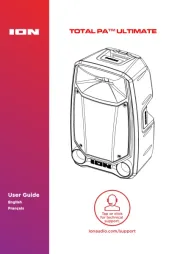
6 September 2024
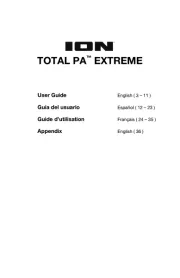
6 September 2024
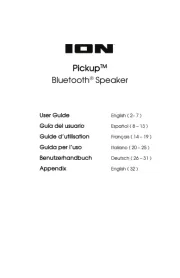
6 September 2024
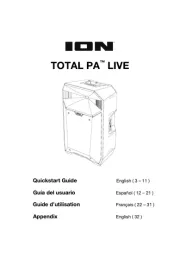
6 September 2024
Handleiding Speaker
- Extron
- MUZEN
- Champion
- Grimm Audio
- Sitecom
- SereneLife
- Wharfedale
- Vision
- Dynacord
- TCL
- Genius
- Energy Sistem
- Audio Design
- Energizer
- Wavemaster
Nieuwste handleidingen voor Speaker
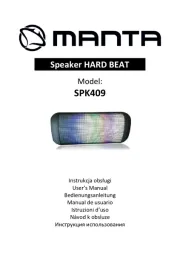
14 September 2025

13 September 2025
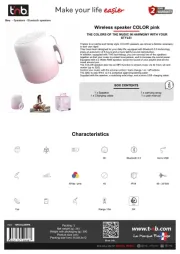
13 September 2025
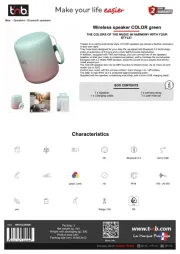
12 September 2025
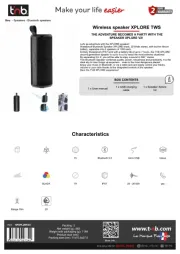
12 September 2025
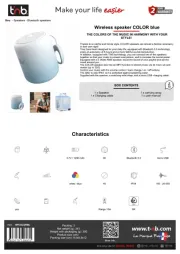
12 September 2025
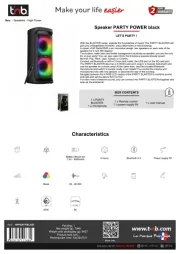
12 September 2025
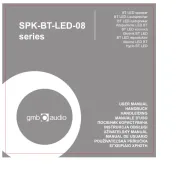
12 September 2025
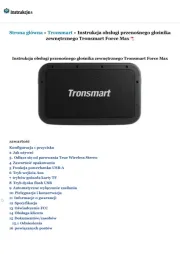
12 September 2025

12 September 2025